非谓语动词-现在分词的讲解
非谓语动词讲解(超全)

非谓语动词讲解(超全)非谓语动词是指动词的非限定形式,不可以独立作谓语。
它可以由动词原形、现在分词和过去分词构成,常见的形式有不定式、动名词和分词。
一、不定式:不定式是动词的一种非限定形式,常常在句中作主语、宾语、表语或定语。
它的构成方式为"to + 动词原形"。
例句:1. To learn a foreign language is not easy.(作主语)2. She wants to go shopping.(作宾语)3. The best way to learn English well is to practice every day.(作表语)4. He has a lot of work to finish.(作定语)不定式也具有进行时态、完成时态和被动语态的形式:进行时态:to be + 动词的现在分词完成时态:to have + 动词的过去分词被动语态:to be + 动词过去分词例句:1. He seems to be sleeping.(不定式进行时态)2. You should have told me earlier.(不定式完成时态)3. The car needs to be repaired.(不定式被动语态)二、动名词:动名词是指动词的-ing形式,它可以作主语、宾语、表语、定语或状语。
在句中的位置和用法与名词相似。
例句:1. Reading is my favorite hobby.(作主语)2. I enjoy swimming in the summer.(作宾语)3. Her dream is becoming a famous singer.(作表语)4. The girl standing over there is my sister.(作定语)5. He went to the party without saying goodbye.(作状语)动名词与不定式的区别在于动名词具有进行时态和被动语态,而不定式没有。
14.突破语法知识—非谓语动词之现在分词-讲义

14.突破语法知识—非谓语动词之现在分词一、动词-ing形式概述动词-ing形式包括现在分词(the present participle)和动名词,是三种非谓语动词之一。
现在分词既具有动词的一些特征,又具有形容词和副词的句法功能。
动名词既具有动词的一些特征,又具有名词的句法功能。
动词-ing形式的功能动词-ing的形式:1.He hurried home,looking behind as he went.2.Having finished their work,they had a rest.3.The large building being built is a library.4.Having been shown the lab,we were taken to see the library.二、现在分词的两个基本特点1、在时间上表示动作正在进行There are many sleeping students in class.2、在语态上表示主动Feeling the lesson is boring,the students are sleepy.三、现在分词的构成1、一般动词,变化:加+ing,例子:wash——washing,read——reading2、以不发音字母e结尾的动词,变化:去掉e,再加+ing,例如:make——making write——writing use——using3、以重读闭音节结尾的动词且末尾只有一个辅音字母,变化:双写最后的辅音字母,再加+ing,例如:run——running,swim——swimming,put——putting4、以ie结尾的动词,变化:改ie为y,再加+ing,例如:lie——lying,die——dying,tie——tying5、以c结尾的动词,变化:变c为ck,再加+ing,例子:picnic→picnicking,traffic→trafficking(例外:arc 作弧形运动,arcing)6、以l结尾的动词,变化:如果动词原形以非重读音节结尾,则末尾的字母l双写与不双写均可。
非谓语动词的时态和语态

非谓语动词的时态和语态非谓语动词是指在句中不充当谓语成分,通常以动词原形或动词的其他非限定形式呈现的动词。
非谓语动词的时态和语态主要根据上下文确定,本文将详细介绍非谓语动词的时态和语态的使用。
一、非谓语动词的时态1. 不定式:不定式作为非谓语动词形式,不受时态的限制,通常表示动作发生在谓语动词所表示的动作之前。
例如:- To understand English well, one must practice every day.(为了能够很好地理解英语,人们必须每天练习。
)- I forgot to buy milk on the way home.(我从没想到,在回家的路上忘了买牛奶。
)2. 现在分词:现在分词作为非谓语动词形式,通常表示与谓语动词所表示的动作同时或一般性的动作。
例如:- Walking along the street, I noticed a small cafe.(在街上走的时候,我注意到了一家小咖啡馆。
)- The teacher was talking to the students, explaining the new lesson.(老师正在和学生们谈话,解释新的课程。
)3. 过去分词:过去分词作为非谓语动词形式,通常表示在谓语动词所表示的动作之前已经完成的动作。
例如:- Having finished his homework, the boy went out to play.(孩子做完作业后,出去玩了。
)- The injured man was taken to the hospital, accompanied by his family.(受伤的人被他的家人陪同着送到了医院。
)二、非谓语动词的语态非谓语动词的语态主要包括主动语态和被动语态,具体如下:1. 不定式的语态:不定式的语态通常与主句的语态保持一致。
例如:- She wants to be promoted.(她想要升职。
现在分词做非谓语动词讲解
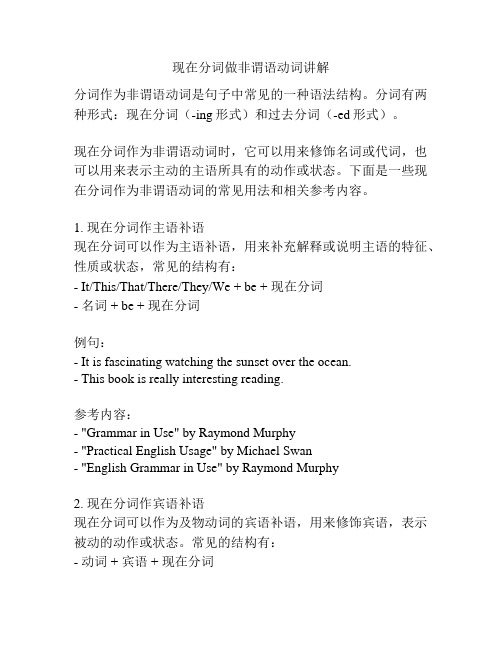
现在分词做非谓语动词讲解分词作为非谓语动词是句子中常见的一种语法结构。
分词有两种形式:现在分词(-ing形式)和过去分词(-ed形式)。
现在分词作为非谓语动词时,它可以用来修饰名词或代词,也可以用来表示主动的主语所具有的动作或状态。
下面是一些现在分词作为非谓语动词的常见用法和相关参考内容。
1. 现在分词作主语补语现在分词可以作为主语补语,用来补充解释或说明主语的特征、性质或状态,常见的结构有:- It/This/That/There/They/We + be + 现在分词- 名词 + be + 现在分词例句:- It is fascinating watching the sunset over the ocean.- This book is really interesting reading.参考内容:- "Grammar in Use" by Raymond Murphy- "Practical English Usage" by Michael Swan- "English Grammar in Use" by Raymond Murphy2. 现在分词作宾语补语现在分词可以作为及物动词的宾语补语,用来修饰宾语,表示被动的动作或状态。
常见的结构有:- 动词 + 宾语 + 现在分词例句:- I found the article quite confusing.- She considers singing in public a great achievement.参考内容:- "English Grammar and Usage" by Leech and Svartvik- "Collins COBUILD English Guides" by John Sinclair- "A Comprehensive Grammar of the English Language" by Randolph Quirk et al.3. 现在分词作状语现在分词可以作为状语,修饰整个句子或者句子中的某个成分,表示时间、原因、方式、条件等。
非谓语动(现在分词和过去分词)

非谓语动词——现在分词一、定义现在分词是由v+ing构成,具有动词的特征,在功能上具有adj.和adv.的特点,在句中可以做定语、表语、宾语补足语和状语等。
之前,即,not dong/not being done/not having done/not having been done.但在having done结构中,never应放在having和done之间,即,having never done。
翻译:Having never been there/Not having been there, I can’t tell you what the place is like.1.一般式:由v+ing构成,语态上表现在分词与其逻辑主语之间是主动关系,在时间上表示进行或与谓语动词同时发生/存在的动作或状态。
填空:1) The girl ______(sing) for us is ten years old.2) _______(wear) a new pair of glasses, she can read easily.2. 完成式:having+done,语态上表示该现在分词与其逻辑主语之间是主动关系,在时间上表示已完成或先于谓语动词的动作或状态。
填空:1) _______(receive) the letter, I know everything is all right.2) ________(have) my supper, I went out for a walk.3. 被动式:1)being done 2)having been done,语态上表示该现在分词短语与其逻辑主语之间是被动关系;时间上being done表示和谓语动词同时发生,having been done表示在谓语动词之前已发生或完成。
填空:The building _________(build) will be completed next year.三、现在分词的用法及功能(一)作定语1. 现在分词作定语时其逻辑主语为其所修饰的名词。
非谓语动词讲解举例子

非谓语动词讲解举例子非谓语动词是指除了谓语动词之外的其他动词形式,包括动词不定式、现在分词和过去分词。
非谓语动词可以在句子中作主语、宾语、定语、状语等成分。
下面将分别介绍非谓语动词的形式及其用法,并举例说明。
1. 动词不定式(to+动词原形)动词不定式一般用在动词后面,可以表示目的、意图、原因、结果等。
例句:- I went to the supermarket to buy some groceries.(我去超市买了一些杂货。
)这里的不定式"to buy"表示目的。
- My friends and I decided to go hiking this weekend.(我和我的朋友决定这个周末去远足。
)这里的不定式"to go"表示动作的意图。
2. 现在分词(动词+ing)现在分词可以用作形容词,表示正在进行的动作。
例句:- The running water is so clear.(流动的水很清澈。
)这里的现在分词"running"作为形容词修饰水。
- I saw a crying child on the street.(我看到了街上一个哭泣的孩子。
)这里的现在分词"crying"作为形容词修饰孩子。
3. 过去分词(一般以-ed、-en或其他形式结尾)过去分词一般用作形容词,表示被动或完成的动作。
例句:- The broken window needs to be repaired.(破损的窗户需要修理。
)这里的过去分词"broken"作为形容词修饰窗户。
- She was thrilled to receive the unexpected gift.(她收到这个意外的礼物感到兴奋。
)这里的过去分词"unexpected"作为形容词修饰礼物。
非谓语动词还有其他用法,如作状语、宾语补足语等,下面是一些例子:- Being a doctor, he is always busy.(作状语)作为一个医生,他总是很忙。
(完整版)名词的非谓语动词形式讲解

(完整版)名词的非谓语动词形式讲解名词的非谓语动词形式是指名词在句子中充当动词而不是名词的功能。
非谓语动词有三种形式:不定式、现在分词和过去分词。
1. 不定式不定式是名词最常见的非谓语动词形式之一。
不定式可以表示目的、愿望、惯以及某些特定的动作或状态。
不定式的形式是“to + 动词原形”。
例如:- I want to go to the beach.(我想去海滩。
)- He likes to play basketball.(他喜欢打篮球。
)2. 现在分词现在分词是动词的一种形式,可以用作形容词或者动词。
现在分词的形式是动词原形加上-ing。
在名词中,现在分词用于描述正在进行的动作或者具有特定特征的人或物。
例如:- The running man is my brother.(那个跑步的人是我哥哥。
)- The interesting book is on the table.(有趣的书在桌子上。
)3. 过去分词过去分词是动词的一种形式,常用作形容词,表示完成的动作或状态。
过去分词的形式有规律变化和不规则变化。
在名词中,过去分词也用于描述或修饰人或物。
例如:- The broken vase was expensive.(那个破损的花瓶很贵。
)- She is interested in the written article.(她对那篇书面文章很感兴趣。
)综上所述,名词的非谓语动词形式主要包括不定式、现在分词和过去分词。
掌握这些形式的用法和规则可以帮助我们更准确地表达自己的意思,并丰富我们的语言表达能力。
*注意:以上内容仅供参考,具体语法使用请根据具体语境和句子结构进行判断和运用。
*。
分词非谓语动词讲解
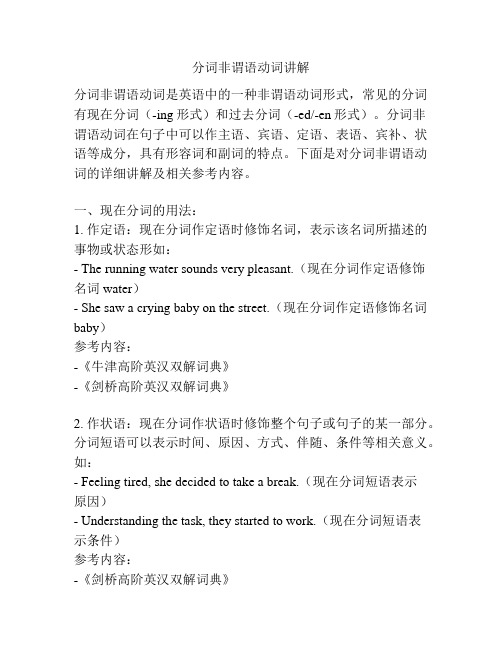
分词非谓语动词讲解分词非谓语动词是英语中的一种非谓语动词形式,常见的分词有现在分词(-ing形式)和过去分词(-ed/-en形式)。
分词非谓语动词在句子中可以作主语、宾语、定语、表语、宾补、状语等成分,具有形容词和副词的特点。
下面是对分词非谓语动词的详细讲解及相关参考内容。
一、现在分词的用法:1. 作定语:现在分词作定语时修饰名词,表示该名词所描述的事物或状态形如:- The running water sounds very pleasant.(现在分词作定语修饰名词water)- She saw a crying baby on the street.(现在分词作定语修饰名词baby)参考内容:-《牛津高阶英汉双解词典》-《剑桥高阶英汉双解词典》2. 作状语:现在分词作状语时修饰整个句子或句子的某一部分。
分词短语可以表示时间、原因、方式、伴随、条件等相关意义。
如:- Feeling tired, she decided to take a break.(现在分词短语表示原因)- Understanding the task, they started to work.(现在分词短语表示条件)参考内容:-《剑桥高阶英汉双解词典》-《英汉大词典》二、过去分词的用法:1. 作定语:过去分词在句中作定语时,修饰名词,表示该名词被动、完成或被描述的状态,如:- The broken vase needs to be repaired.(过去分词作定语修饰名词vase)- The information provided is accurate.(过去分词作定语修饰名词information)参考内容:-《朗文当代高级英语辞典》-《剑桥国际英语高级词典》2. 作表语:过去分词可以作表语,表示主语的状态或特征,如:- He is interested in the books written by the famous author.(过去分词作表语修饰主语)- The glass is broken.(过去分词作表语修饰主语)参考内容:-《剑桥高阶英汉双解词典》-《牛津高阶英汉双解词典》三、分词作宾补的用法:分词非谓语动词可以作及物动词的宾语补足语,表示被动、完成的意义,如:- She found the door locked.(分词作宾补修饰宾语door)- They heard the news announced on the radio.(分词作宾补修饰宾语news)参考内容:-《韦氏英语用法词典》-《剑桥高阶英汉双解词典》综上所述,分词非谓语动词的用法主要包括现在分词作定语、状语,过去分词作定语、表语和宾补等。
非谓语动词-现在分词的讲解

非谓语动词非谓语动词包括不定式(to do)、动名词(-ing)、现在分词(-ing)与过去分词(-ed)。
它们不受主语人称和数的限制,在句子中不能充当谓语,但可以充当句子的其他成分,并且有时态和语态的变化。
动词ing形式的要点1.ing的形式2.ing形式的基本用法…(1)作主语:Seeing is believing. 眼见为实。
(2)作表语:Her job is washing and cooking.(3)作宾语:①作及物动词的宾语。
She likes drawing very much.②作某些短语动词的宾语。
Mary is thinking of going back to New York.③ do+限定词(my, some, any, the等)+v.ing,表示“做…事”之如do some cleaning打扫卫生do some shopping购物④作介词的宾语:Her sister is good at learning physics.⑤作形容词worth, busy等的宾语:This book is well worth reading.只接动词-ing形式而不接不定式作宾语的动词有:【admit 承认appreciate 感激avoid 避免put off推迟keep 保持consider 考虑delay/ postpone耽搁dislike 嫌恶resist 抵制mention 提及enjoy 喜欢escape 避免excuse 原谅practice 练习mind介意fancy想不到feel like 意欲finish 完成risk 冒险include 包括forgive 原谅give up 放弃suggest 建议miss 逃过imagine 想象can’t help 情不自禁involve 需要can’t stand无法忍受understand 理解常见的带介词to的短语:be used to 习惯be related to 与……有关get down to 着手做contribute to 贡献put one’s mind to全神贯注于give rise to 引起be equal to 胜任devote oneself to 献身于lead to 导致be opposed to 反对look forward to 盼望object to 反对stick to 坚持payattention to 注意(4)作定语:The sleeping child is only five years old.(5)作宾语补足语:We can see steam rising from the wet clothes.可以带有这种复合宾语的动词有see, watch, hear, observe, feel, find, have, keep等。
非谓语动词讲解(超全

非谓语动词讲解(超全非谓语动词是指动词的非谓语形式,包括动词不定式、动名词和现在分词。
与主谓结构不同,非谓语动词可在句子中作状语、定语或表语。
在英语中,非谓语动词的形式是相对固定的,但在不同的语法环境中所表示的意义和用法有所差异。
1. 动词不定式(to-infinitive)动词不定式由“to + 动词原形”构成,常常用作动词的宾语、主语、状语或定语。
例如:- 宾语:I want to go to the zoo.(我想去动物园。
)- 主语:To speak English fluently is important for your career.(流利地说英语对你的事业很重要。
)- 状语:He went to the store to buy some groceries.(他去商店买了些杂货。
)- 定语:She needs a pen to write her essay.(她需要一支笔来写作文。
)2. 动名词(gerund)动名词是将动词加上-ing构成,常常用作动词的宾语、主语、状语或定语。
例如:- 宾语:I enjoy reading books in my spare time.(我闲暇时喜欢读书。
)- 主语:Swimming is good exercise.(游泳是很好的锻炼。
)- 状语:She left the party early, feeling tired.(她因为感觉累了,所以提前离开了聚会。
)- 定语:The crying baby woke up the whole neighborhood.(哭闹的婴儿把整个邻居都吵醒了。
)3. 现在分词(present participle)现在分词由动词原形加上-ing构成,常常用作动词的宾语、主语、状语或定语。
例如:- 宾语:He enjoys playing soccer on weekends.(他喜欢周末踢足球。
)- 主语:Listening to music helps me relax.(听音乐帮助我放松。
非谓语动词讲解史上最全

非谓语动词讲解史上最全非谓语动词是英语中的一种特殊动词形式,它们在句子中通常不具备时态和人称的变化。
非谓语动词包括不定式、动名词和现在分词。
一、不定式(Infinitive)不定式由to加动词原形构成,具有动词和名词的双重特征。
不定式在句子中可以作主语、宾语、表语、定语、状语等成分。
1. 作主语:To learn a foreign language is beneficial to your career.学习一门外语对你的事业有益。
2. 作宾语:I want to visit my grandparents this weekend.我想这周末去看望我的祖父母。
3. 作表语:His dream is to become a famous writer.他的梦想是成为一名著名的作家。
4. 作定语:She has many books to read.她有很多书要读。
5. 作状语:He came to help us.他来帮助我们。
二、动名词(Gerund)动名词由动词原形加-ing构成,具有动词和名词的双重特征。
动名词在句子中可以充当主语、宾语、表语、定语、状语等成分。
1. 作主语:Swimming is my favorite sport.游泳是我最喜欢的运动。
2. 作宾语:I enjoy reading novels in my free time.我喜欢在空闲时间读小说。
3. 作表语:Her hobby is singing.她的爱好是唱歌。
4. 作定语:The running water is clear.流动的水很清澈。
5. 作状语:She went shopping after finishing her homework.她在完成作业后去购物。
三、现在分词(Present Participle)现在分词由动词原形加-ing构成,具有动词和形容词的双重特征。
现在分词在句子中可以充当定语、表语、状语等成分。
(完整word)非谓语动词现在分词和过去分词的用法
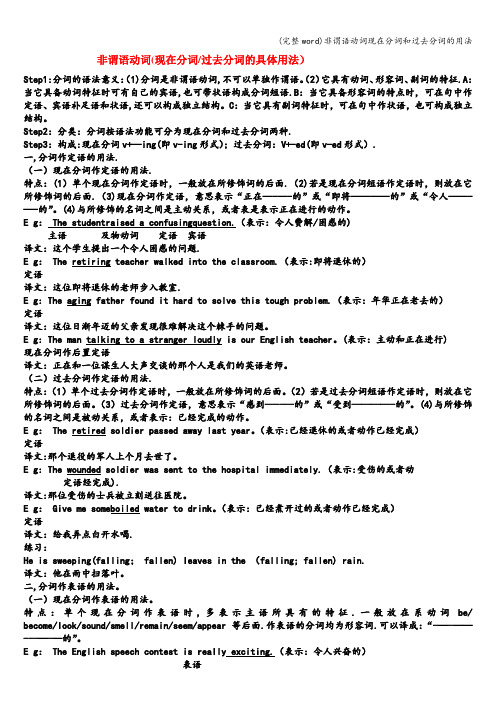
非谓语动词(现在分词/过去分词的具体用法)Step1:分词的语法意义:(1)分词是非谓语动词,不可以单独作谓语。
(2)它具有动词、形容词、副词的特征.A:当它具备动词特征时可有自己的宾语,也可带状语构成分词短语.B:当它具备形容词的特点时,可在句中作定语、宾语补足语和状语,还可以构成独立结构。
C:当它具有副词特征时,可在句中作状语,也可构成独立结构。
Step2:分类:分词按语法功能可分为现在分词和过去分词两种.Step3:构成:现在分词v+—ing(即v-ing形式);过去分词:V+-ed(即v-ed形式).一,分词作定语的用法.(一)现在分词作定语的用法.特点:(1)单个现在分词作定语时,一般放在所修饰词的后面.(2)若是现在分词短语作定语时,则放在它所修饰词的后面.(3)现在分词作定语,意思表示“正在—-—-的”或“即将——-—-的”或“令人—---—-的”。
(4)与所修饰的名词之间是主动关系,或者表是表示正在进行的动作。
E g: The studentraised a confusingquestion.(表示:令人费解/困惑的)主语及物动词定语宾语译文:这个学生提出一个令人困惑的问题.E g: The retiring teacher walked into the classroom.(表示:即将退休的)定语译文:这位即将退休的老师步入教室.E g: The aging father found it hard to solve this tough problem.(表示:年华正在老去的)定语译文:这位日渐年迈的父亲发现很难解决这个棘手的问题。
E g: The man talking to a stranger loudly is our English teacher。
(表示:主动和正在进行)现在分词作后置定语译文:正在和一位谋生人大声交谈的那个人是我们的英语老师。
(二)过去分词作定语的用法.特点:(1)单个过去分词作定语时,一般放在所修饰词的后面。
非谓语动词分词的用法总结

非谓语动词分词的用法总结一、非谓语动词分词的基本概念及形式非谓语动词分词是英语中的一种特殊用法,常用来表达被动、完成、主动等不同含义。
在句子中作为定语、状语或补语,并且有时可以替代从句。
它的形式通常为“过去分词”或“现在分词”,具体使用取决于上下文和句子结构。
1. 过去分词过去分词通常由动词原形后加上-ed或-d构成,如:played, taken, finished等。
它可以表示被动意义,也可以表示稍微延续的状态或完成的行为。
2. 现在分词现在分词通常由动词原形后加-ing构成,如:playing, taking, working等。
它可以表示主动进行的行为,同时也具有形容词性质。
二、非谓语动词分词作定语非谓语动词分词可以用作定语来修饰名词,起到进一步说明、限定名次的作用。
1. 过去分词作定语过去分词作为定语时,通常修饰被其所描述的名次,如:broken heart (破碎的心) ,cooked rice (煮熟的米饭)等。
它可以表示被动或完成的状态。
2. 现在分词作定语现在分词作为定语时,通常修饰与之相关的名次,并且描述正在进行或主动发生的行为,如:a running river (奔流的河流) ,a barking dog (叫唤的狗)等。
三、非谓语动词分词作状语非谓语动词分词可以用作状语来修饰句子、从句或名词短语,起到表示时间、原因、方式、条件等不同功能的作用。
1. 过去分词作状语过去分词作为状语时,可以表示原因、结果、条件、时间等。
例如:Having finished his homework, he went out to play. (完成了家庭作业后,他出去玩了)2. 现在分词作状语现在分词作为状语时,可以表达同时进行、原因、方式等含义。
例如:Walking slowly, she enjoyed the beautiful scenery. (慢慢地走着,她欣赏美丽的风景)四、非谓语动词分词作补语非谓语动词分词还可以用来充当及物动词的宾补或形容词的补足语,起到补充说明、进一步描述的作用。
非谓语动词之现在分词与过去分词区别

非谓语动词之“现在分词”的用法现在分词由“动词原形+ing”构成,具有动词的特点,在句中可作宾语补足语,定语,状语。
一、作宾语补足语。
(有“主动”的意思)感官动词后可用现在分词作宾语补足语。
感官动词有:一感。
(feel)二听。
(hear,listen to)四看。
(see,watch,notice,find)如:I heard the girl singing an English song when I came into the room.例题:1.-Do you often find Tom (play)on the playground after school ?-Y es,and I found him (play)on the playground just now .2. – Do you often see Mary (draw)picture in her room ?- Y es,and she was seen (draw)a horse just now.区别:现在分词作宾补表示宾语动作的瞬间,省to不定式作宾补表示宾语动作的过程。
补充:keep sb doing sth 使某人干某事,stop sb doing sth 阻止某人干某事二、作定语。
(有“主动”的意思)1、There is a girl singing an English song in the room. 有个女孩在房间里唱英文歌。
2、The man wearing a black coat may be Lucy’s father .穿着黑色外套的那个男子可能是Lucy 的爸爸。
例题:1、This is the best way (solve)the problem.2、I know the woman (wait)at the bus stop.区别:现在分词作定语有被修饰的人“正在做某事”的意思,但动词不定式没有。
高中英语非谓语动词讲解

高中英语非谓语动词讲解非谓语动词包括不定式(to do)、动名词(-ing)、现在分词(-ing)和过去分词(-ed)。
它们不受主语人称和数的限制,不能充当谓语,但可以充当句子的其他成分,并且有时态和语态的变化。
动词不定式没有人称和数的变化,不能独立作谓语,但可以有自己的宾语和状语。
一般式表示的动作或状态发生在谓语动词表示的动作或状态的同时或之后,而进行式表示动作正在进行,与谓语的动作同时发生。
动名词相当于名词,可以作主语、宾语、表语、宾补、定语和状语。
它往往有将来意味,指经常性、惯性的动作或有现在意味。
现在分词和过去分词分别相当于形容词和副词,可以作定语和状语。
现在分词往往有进行意味,而过去分词则表示被动或完成的意义。
在上述各种非谓语动词形式之前直接加not可以构成否定式。
此外,动词不定式还有完成式、进行式和完成进行式,分别表示完成、正在进行和完成正在进行的动作或状态。
被动形式则表示该动作或状态的承受者。
需要注意的是,当不定式的逻辑主语是这个不定式所表示的动作的承受者时,不定式一般要用被动式(to be done)。
例如,The building to be finished next month is for our ___.3.关于不定式的完成式:当不定式所表示的动作或状态发生在谓语动词所表示的动作或状态之前时,使用完成式。
如果带有被动含义,则使用完成被动式(to have been done)。
例如:据说他写了一本关于长征的小说。
他据说在儿时学过法语。
4.关于不定式的完成进行式:如果不定式的动作在谓语所表示的时间之前一直在进行或可能继续进行,则使用完成进行式。
例如:我们很高兴一整个月都在和专家们一起工作。
二、不定式的用法:1.不定式做主语:不定式作主语一般表示具体的某次动作,而动名词doing则表示惯性的、经常性的动作。
具体表现为:1)不定式作主语时,谓语使用单数形式,例如:做这样的事情是愚蠢的。
现在分词非谓语动词的用法总结

现在分词非谓语动词的用法总结以现在分词非谓语动词的用法为话题,首先我们需要了解现在分词的定义和基本用法。
现在分词是动词的一种非谓语形式,它通常和主语之间具有逻辑上的关系,用来修饰名词或作状语。
在文章中,我们将从简单到复杂地探讨现在分词的基本用法,包括作状语、作定语、代替状语从句等方面。
第一,现在分词的基本用法之一是作状语。
现在分词作状语时,它可以表示伴随、时间、原因、条件、让步等各种状语关系,用来修饰句子的谓语动词,增加句子的信息量和表达的灵活性。
比如:“她边唱着歌,边跳舞。
”这里的“唱着”和“跳舞”就是分别表示伴随关系的现在分词。
第二,现在分词的另一个基本用法是作定语。
现在分词作定语时,它通常用来修饰名词或代词,起到修饰、限定、描绘名词的作用。
比如:“一位正在读书的学生”。
这里的“正在读书的”就是现在分词作定语,修饰名词“学生”,表示学生正在读书这一动作。
第三,现在分词还可以代替状语从句,从而简化句子结构,使表达更加简洁明了。
比如:“我一边吃饭,一边看书。
”可以改为“我一边吃饭,一边看着书”。
这里的“看着”就代替了状语从句“我看着书”。
现在分词非谓语动词有着丰富的用法,它可以作状语、定语,并且还可以代替状语从句,使句子更加简洁明了。
通过对现在分词的用法进行总结和回顾,我们可以更全面、深刻地理解这一语法现象。
从个人观点来看,我认为掌握好现在分词的用法,可以帮助我们写出更加丰富多彩、灵活多变的句子,使语言表达更加生动和有趣。
通过对现在分词的用法进行总结和回顾,我们可以更全面、深刻地理解这一语法现象。
掌握好现在分词的用法,可以帮助我们写出更加丰富多彩、灵活多变的句子,使语言表达更加生动和有趣。
现在分词的基本用法包括作状语、作定语以及代替状语从句。
在这些基本用法的基础上,现在分词还有许多其他的用法,比如表条件、目的、结局、方式、结果等。
接下来,我们将继续探讨现在分词的更多用法,以及如何正确地运用它们。
非谓语全讲解之分词(无盲区版)
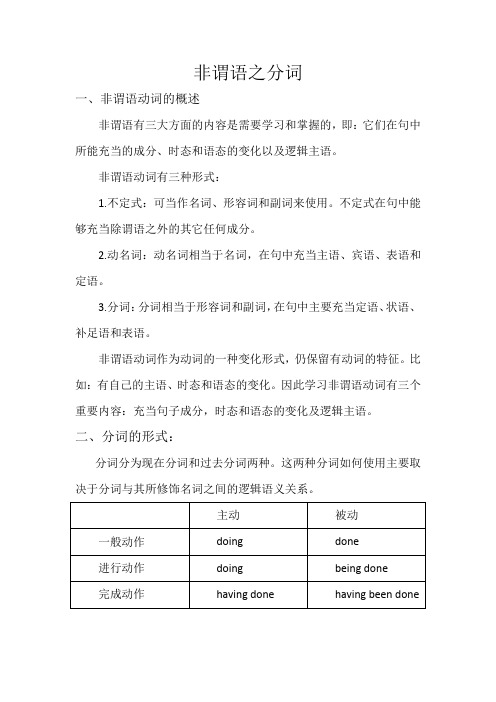
非谓语之分词一、非谓语动词的概述非谓语有三大方面的内容是需要学习和掌握的,即:它们在句中所能充当的成分、时态和语态的变化以及逻辑主语。
非谓语动词有三种形式:1.不定式:可当作名词、形容词和副词来使用。
不定式在句中能够充当除谓语之外的其它任何成分。
2.动名词:动名词相当于名词,在句中充当主语、宾语、表语和定语。
3.分词:分词相当于形容词和副词,在句中主要充当定语、状语、补足语和表语。
非谓语动词作为动词的一种变化形式,仍保留有动词的特征。
比如:有自己的主语、时态和语态的变化。
因此学习非谓语动词有三个重要内容:充当句子成分,时态和语态的变化及逻辑主语。
二、分词的形式:分词分为现在分词和过去分词两种。
这两种分词如何使用主要取决于分词与其所修饰名词之间的逻辑语义关系。
二、分词的意义:★现在分词的意义:从时态和语态两个角度分析分词的意义。
从语态看,现在分词表示主动意义,从时态看,现在分词表示进行的动作,相当于一个进行时态,同时还可以表示一般的动作,相当于一个一般时态。
1、主动,进行的动作。
例:①falling leaves 正在飘落的叶子②A sleeping dog 正在睡觉的狗③The man standing at the gate is my English teacher.站在门口的那个人是我们的英语老师。
④I like the girl dancing with that guy. 我喜欢正在和那个小伙子跳舞的女孩。
2、主动,一般的动作(表示某事物一贯特征)此用法表示的是所修饰名词的一种持久性的特点。
例:①flying fishes 飞鱼②A puzzling problem 令人迷惑的问题③They live in a room facing the south.他们住在一间朝南的屋子里。
=they live in a room that faces the south.★过去分词的意义:对于过去分词含义的理解,须区分及物动词和不及物动词。
非谓语动词讲解 超全

非谓语动词讲解超全非谓语动词是指不具有人称和数的动词形式,不需要依附主语就可以使用的动词形式。
非谓语动词包括动词不定式、动名词和现在分词等形式。
非谓语动词的使用可以丰富句子结构,增强表达效果,表达出动作的进行、完成、目的、原因等不同的语义关系。
一、动词不定式动词不定式是动词的一种非谓语形式,由“to” + 原形动词构成,具有名词、形容词或副词的特性。
1. 作主语:To learn English well is my goal.(学好英语是我的目标。
)2. 作宾语:I want to take a nap.(我想睡个觉。
)3. 作宾补:She found it difficult to solve the math problem.(她发现解决这个数学问题很困难。
)4. 作表语:My dream is to become a teacher.(我的梦想是成为一名教师。
)5. 作状语:He left the room to make a phone call.(他离开房间去打电话。
)二、动名词动名词是动词的一种非谓语形式,多用于表示动作的稳定状态或被动的形式,常常作主语、宾语或介词的宾语。
1. 作主语:Swimming is my favorite sport.(游泳是我最喜欢的运动。
)2. 作宾语:I enjoy reading books.(我喜欢阅读书籍。
)3. 作宾补:He kept silent, not wanting to reveal the secret.(他保持沉默,不想泄露秘密。
)4. 作介词的宾语:She is good at playing the piano.(她擅长弹钢琴。
)三、现在分词现在分词是动词的一种非谓语形式,通常以-ing结尾,可以表示主动、进行、伴随等含义。
1. 作定语:The running dog scared the child.(奔跑的狗吓唬了孩子。
非谓语动词不定式和现在分词的区别-概述说明以及解释

非谓语动词不定式和现在分词的区别-概述说明以及解释1.引言1.1 概述非谓语动词不定式和现在分词是英语语法中的两种重要结构,它们在句子中起着非常重要的作用。
在学习英语的过程中,很多人会对这两种结构产生困惑,无法准确地区分它们的用法。
因此,本文旨在探讨非谓语动词不定式和现在分词的特点,比较它们之间的区别,从而帮助读者更好地理解和运用这两种语法结构。
非谓语动词不定式和现在分词在句子中的作用各有不同,对于初学者来说往往容易混淆。
通过对它们的特点和区别进行深入分析,可以帮助我们更清晰地理解它们的用法,提高语法水平。
随着文章的深入,我们将逐步探讨非谓语动词不定式和现在分词各自的特点,以及如何正确使用它们。
同时,我们也将强调学习非谓语动词的重要性,并总结文章的主要观点,以期帮助读者更好地掌握这两种语法结构。
1.2 文章结构:本文主要分为引言、正文和结论三个部分。
在引言部分,将对非谓语动词不定式和现在分词进行简要介绍,并说明文章的结构和目的。
在正文部分,将分别详细讨论非谓语动词不定式和现在分词的特点,并重点比较它们之间的区别。
最后,在结论部分,将总结非谓语动词不定式和现在分词的用法,强调学习非谓语动词的重要性,并进行文章的结束语。
通过这样清晰的结构安排,读者能够更好地理解非谓语动词不定式和现在分词之间的区别,提高语法水平。
1.3 目的:本文旨在对非谓语动词不定式和现在分词进行比较和分析,明确它们在语法结构和用法上的区别。
通过深入解析两者的特点和区别,读者将能够更清楚地理解和正确运用非谓语动词不定式和现在分词,提高语言表达的准确性和流畅性。
同时,文章旨在强调学习非谓语动词的重要性,帮助读者掌握语言规范,提升写作和口语能力。
通过本文的阅读,读者将对非谓语动词的使用有更全面的认识,为进一步提升语言水平打下坚实基础。
2.正文2.1 非谓语动词不定式的特点非谓语动词不定式指的是动词原形加上to构成的形式,通常用来表示目的、原因、结果、条件、伴随等。
非谓语动词分词的用法总结归纳
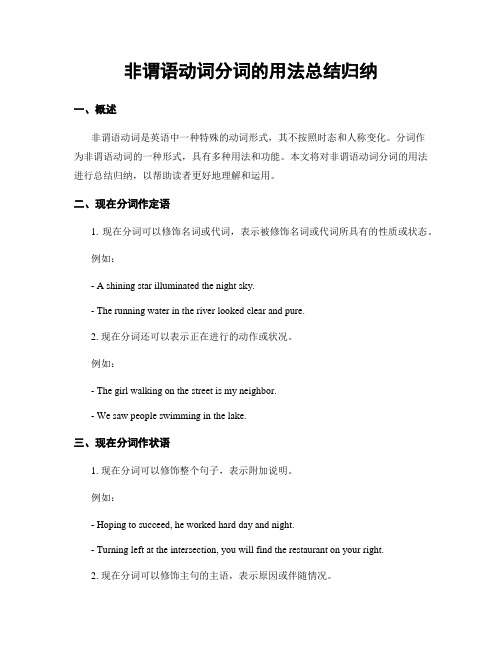
非谓语动词分词的用法总结归纳一、概述非谓语动词是英语中一种特殊的动词形式,其不按照时态和人称变化。
分词作为非谓语动词的一种形式,具有多种用法和功能。
本文将对非谓语动词分词的用法进行总结归纳,以帮助读者更好地理解和运用。
二、现在分词作定语1. 现在分词可以修饰名词或代词,表示被修饰名词或代词所具有的性质或状态。
例如:- A shining star illuminated the night sky.- The running water in the river looked clear and pure.2. 现在分词还可以表示正在进行的动作或状况。
例如:- The girl walking on the street is my neighbor.- We saw people swimming in the lake.三、现在分词作状语1. 现在分词可以修饰整个句子,表示附加说明。
例如:- Hoping to succeed, he worked hard day and night.- Turning left at the intersection, you will find the restaurant on your right.2. 现在分词可以修饰主句的主语,表示原因或伴随情况。
例如:- Being tired, she decided to take a break.- Having finished his homework, John went out for a walk.四、过去分词作定语1. 过去分词可以修饰名词或代词,表示被修饰名词或代词所受到的动作或影响。
例如:- The broken vase needs to be replaced.- I saw a damaged car on the side of the road.2. 过去分词还可以表示完成的动作或状态。
- 1、下载文档前请自行甄别文档内容的完整性,平台不提供额外的编辑、内容补充、找答案等附加服务。
- 2、"仅部分预览"的文档,不可在线预览部分如存在完整性等问题,可反馈申请退款(可完整预览的文档不适用该条件!)。
- 3、如文档侵犯您的权益,请联系客服反馈,我们会尽快为您处理(人工客服工作时间:9:00-18:30)。
非谓语动词非谓语动词包括不定式(to do)、动名词(-ing)、现在分词(-ing)与过去分词(-ed)。
它们不受主语人称和数的限制,在句子中不能充当谓语,但可以充当句子的其他成分,并且有时态和语态的变化。
动词-ing形式的要点1.-ing的形式2.-ing形式的基本用法(1)作主语:Seeing is believing. 眼见为实。
(2)作表语:Her job is washing and cooking.(3)作宾语:①作及物动词的宾语。
She likes drawing very much.②作某些短语动词的宾语。
Mary is thinking of going back to New York.③ do+限定词(my, some, any, the等)+v.-ing,表示“做…事”之如do some cleaning打扫卫生do some shopping购物④作介词的宾语:Her sister is good at learning physics.⑤作形容词worth, busy等的宾语:This book is well worth reading.只接动词-ing形式而不接不定式作宾语的动词有:admit 承认appreciate 感激avoid 避免put off推迟keep 保持consider 考虑delay/ postpone耽搁dislike 嫌恶resist 抵制mention 提及enjoy 喜欢escape 避免excuse 原谅practice 练习mind介意fancy想不到feel like 意欲finish 完成risk 冒险include 包括forgive 原谅give up 放弃suggest 建议miss 逃过imagine 想象can’t help 情不自禁involve 需要can’t stand无法忍受understand 理解常见的带介词to的短语:be used to 习惯be related to 与……有关get down to 着手做contribute to 贡献put one’s mind to全神贯注于give rise to 引起be equal to 胜任devote oneself to 献身于lead to 导致be opposed to 反对look forward to 盼望object to 反对stick to 坚持pay attention to 注意(4)作定语:The sleeping child is only five years old.(5)作宾语补足语:We can see steam rising from the wet clothes.可以带有这种复合宾语的动词有see, watch, hear, observe, feel, find, have, keep等。
(6)作状语:①时间状语:Seeing Tom, I couldn't help thinking of his brother.分词在句中作时间状语时,其前一般可加when或while,如:When crossing street, you must be careful.②原因状语:Being ill, he didn't go to school yesterday.③方式或伴随状语:Mary stood at the school gate waiting for Betty.3. 主动语态-ing完成式的基本用法。
主动语态-ing完成式所表示的动作发生在句中谓语动词所表示的动作之前,一般在句中作时间或原因状语用。
句中的主语是它的逻辑主语,并且是它所表示的动作的执行者,如:Having answered the letter, she went on to read an English novel.4. 被动语态-ing一般式的基本用法。
被动语态-ing一般式所表示的动作是一个正在进行中的被动动作,而且这个被动动作也是和句中谓语所表示的动作同时发生的。
它一般在句中作定语或状语用。
如:The truck being repaired there is ours.5. 被动语态-ing完成式的基本用法。
被动语态-ing完成式所表示的动作发生在谓语动词所表示的动作之前,在句中一般作状语用。
如:Having been shown the lab, we were taken to see the library.6. -ing形式的复合结构。
在-ing前加物主代词或名词所有格即构成-ing的复合结构。
其中的物主代词或名词所有格为-ing的逻辑主语。
这种结构在句中可作主语、宾语或表语,如:Your smoking and drinking too much will do harm to your health.7.分词独立主格结构当分词的逻辑主语与主句的主语不同时,带逻辑主语的分词短语成为独立主格结构,在句法功能上起状语作用。
例如:Weather permitting, they will go and visit the science museum.The meeting being over, they all left the room.Given more time, we could do it better.The moon appearing, they decided to go on with their journey.She stood there, book in hand.Everybody at home, we sat down to dinner.8. with + 复合宾语结构(1)with + 名词/ 代词+ 形容词Don’t speak with your mouth full.(2)with + 名词/ 代词+ 副词The square looks more beautiful than ever with the lights on.(3)with + 名词/ 代词+ 介词短语He was asleep with his head on his arms.(4)with + 名词/ 代词+ -ing分词She felt very nervous with so many people looking at her.With the old man leading, the two started toward the mountains.(5)with + 名词/ 代词+ 不定式With five minutes to go before the last train left, we arrived here.(6)with + 名词/ 代词+ -en分词With his matter settled, we left the room.【2012全国卷II】⒑ Tony lent me the money, ___ that I’d do as much for him.A. hopingB. to hopeC. hopedD. having hoped【答案】A【2012重庆】23. ______to work overtime that evening, I missed a wonderful film.A. Having been askedB. To askC. Having askedD. To be asked 【答案】A【答案】A【2012全国】28. The party will be held in the garden,weather .A. permittingB. to permitC. permittedD. permit【答案】A【2012北京】23. One learns a language by making mistakes and______ them.A. correctsB. correctC. to correctD. correcting【答案】D【2012福建】34. Pressed from his parents, and ____ that he has wasted too much time, the boy is determined to stop playing video games.A. realizingB. realizedC. to realizeD. being realized【答案】A【2012陕西】15. _______ in a long queue, we waited for the store to open to buy a New iPad.A. StandingB. To standC. StoodD. Stand【答案】A【2012湖南】31. The lecture, _____ at 7:00 pm last night, was followed by an observation of the moon with telescopes.A. startingB. being startingC. to startD. to be started【答案】A【2012天津】11. He got up late and hurried to his office, ______ the breakfast untouched.A. leftB. to leaveC. leavingD. having left【答案】C【2012辽宁】25. The old couple often take a walk after super in the park with their pet dog ____.A. to followB. followingC. followedD. follows【答案】B【2012四川】8. I looked up and noticed a snake ______ its way up the tree to catch its breakfast.A. to windB. windC. windingD. wound【答案】C。
